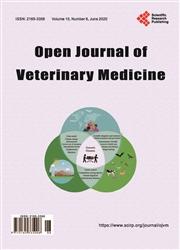Sero-Prevalence and Risk Factors of Diffusion of Peste des Petits Ruminants in Cameroon
引用次数: 0
Abstract
The present study was carried out between April 2015 and January 2016 to estimate the sero-prevalence and identify the risk factors of the peste des petits ruminants (PPR) in Cameroon. A total of 269 herds randomly sampled across the country have been studied and 1622 samples of serum have been levied on the sheep and goat. The c-ELISA has been studied in order to detect the presence of antibodies in small ruminants like an indicator of exposition to PPRV. The results revealed the circulation of PPRV in the country with a total sero-prevalence of 39% [95%CI; 37 - 41] and a sero-prevalence of 63.2% [95%CI; 57.2 - 69.2] at the herd level. Sero-prevalence was variable in the ten regions ranging from 7% [95% CI; 6.2 - 8.4] to 73% [95% CI; 62 - 84] with the northern zone (Adamawa, North and Far-North) having 52.3% [95% CI; 37 - 60] and southern zone (including the remaining seven regions) recording 29% [95% CI; 11 - 57]. Similarly, it was higher in animals found in urban/peri-urban areas than in rural areas with prevalence ratio of 2.9 [95% CI 2.54 - 3.4; p i.e. 3 times more, 1.6 [95% CI 1.36 - 1.90; p i.e. 1.6 times more, and 5.02 [95% CI 3.91 - 6.85; p i.e. 5 times more at national level, in the northern zone and in the southern area, respectively. Five risk factors have been identified: the breeding environment, introduction of new animals into the herds, gathering of animals for pasture and watering, wandering and transhumance. The breeding area appeared to be the most important risk factor associated with disease exposure. The control measures for the eradication of this disease must take into account the epidemiological situation, the breeding environment, animal transhumance and breeding system.喀麦隆小反刍兽疫的血清流行及传播危险因素
本研究于2015年4月至2016年1月期间开展,目的是估计喀麦隆小反刍兽疫(PPR)的血清流行率并确定危险因素。在全国范围内随机抽取269个畜群进行研究,抽取绵羊和山羊血清样本1622份。为了检测小反刍动物体内抗体的存在,研究了c-ELISA,作为暴露于PPRV的指标。结果显示,该国PPRV的总血清流行率为39% [95%CI;37 - 41]血清患病率为63.2% [95%CI;57.2 - 69.2]在畜群水平。10个地区的血清患病率各不相同,从7% [95% CI;6.2 - 8.4]至73% [95% CI;62 - 84]北部地区(Adamawa、北部和远北部)占52.3% [95% CI;37 - 60]南区(包括其余7个地区)记录29% [95% CI;[11 - 57]。同样,城市/城市周边地区的动物患病率高于农村地区,为2.9[95%可信区间2.54 - 3.4;p = 3倍以上,1.6 [95% CI 1.36 - 1.90;p = 1.6倍,5.02 [95% CI 3.91 - 6.85;P即在全国、北部地区和南部地区分别是5倍以上。已确定了五个风险因素:繁殖环境、将新动物引入畜群、为放牧和浇水而聚集动物、流浪和迁移。养殖区似乎是与疾病暴露相关的最重要风险因素。根除该病的控制措施必须考虑流行病学情况、养殖环境、动物转牧和养殖制度等因素。
本文章由计算机程序翻译,如有差异,请以英文原文为准。
求助全文
约1分钟内获得全文
求助全文

 求助内容:
求助内容: 应助结果提醒方式:
应助结果提醒方式:


